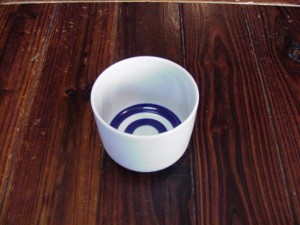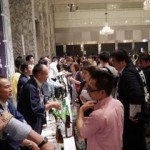 This past Sunday, the well-known sake uber distributor Hasagawa Saketen held their yearly “Kuramoto wo Kakomu-kai,” or “Hanging out with Sake Brewers” evening. Loose translations notwithstanding, it is a party that follows a tasting contest.
This past Sunday, the well-known sake uber distributor Hasagawa Saketen held their yearly “Kuramoto wo Kakomu-kai,” or “Hanging out with Sake Brewers” evening. Loose translations notwithstanding, it is a party that follows a tasting contest.
Hasegawa-san is a distributor with perhaps a half-dozen retail shops selling an outstanding lineup of sake in the Tokyo area. Their stores are all in very well-trodden places: Tokyo Station, Omotesando, Roppongi, Palace Hotel, Tokyo Sky Tree – basically places with foot traffic that makes Times Square look like the Death Valley in terms of numbers of visitors. Every year, they have a tasting competition judged by a conglomeration of brewery owners, master brewers, industry professionals and (occasionally) dorks like me. In the past years in which I have participated, we would taste from like 8am to 2pm, then be expected to show up in the several-hundred-in-attendance party from six. The second half of that day is, to say the least, overwhelming.
After tasting so many sake, spitting of course, but absorbing through the tongue and aromas, I am way too hammered to think about setting foot in a party.
I have judged before in the one-day event, but this time only judged in the finals – along  with 200 sake brewers. Which is what makes this event so cool, in my opinion. (More about that later.) The prelims were held the day before, when the poor bastards that were judges on that day cut 790 sake down to the 420 we had to taste.
with 200 sake brewers. Which is what makes this event so cool, in my opinion. (More about that later.) The prelims were held the day before, when the poor bastards that were judges on that day cut 790 sake down to the 420 we had to taste.
So, we had to taste and score 420 sake in one day. Nay, belay that: in four friggin’ hours. That’s why I was too hammered to think about setting foot in a party, or drinking more sake. But I digress.
To me, it was an outstanding tasting with cool results. There were 200 judges. All gave a 1 to a 5 – that is it. All were experienced. They make the stuff, for gad’s sake. It was totally blind: we had no idea what anything was that we were tasting. It was all done in white kikichoko and separated only by grade.
The group of judges was great, I think. Sure, international panels are great for getting sake to be more appreciated overseas. And pro judges are great for finding flaws. But a large group of mostly younger folks that make it and sell it to me is a great statement of reality about what is good these days.
So, I have taken a long time to get to the point here, but the results of this tasting were totally shocking. Why? Because the winners were sake that are massively popular these days. Maybe this is an indication of how little faith I have in the average consumer. But too often things sell on name alone. Consumers order a handful of brands cuz they have heard, over and over, that they are good. And those of us that like to think we are not slaves to marketing tend to flee from those brands at high speed, hoping to be immune from hype.
But all too often we forget that there is a reason famous brands are famous. There is a reason everyone loves the same few brands. They’re good. And those of us that avoid them because they are simply what everyone else professes to like, well, we may lose out…
And that is what blind tasting solves.
In any event, the winners of the four categories (junmai-shu, junmai ginjo, junmai daiginjo and yamahai/kimoto) were surprisingly unsurprising. They are all hyper famous, very well selling brands. And remember: the tasting was blind, and by 200 of their peers, i.e. dudes and dude-esses that make the stuff. You’d think these folks if anyone would have their own opinions about what is good and not side with the masses. And you’d be right: they do, and they don’t. Which is why to me, what is surprising about them is that it’s no surprise. The very famous brands of late are very famous because anyone – first time consumers and brewing world colleagues alike – think it tastes damn good.
Note this is NOT a license for you to not bother to develop your own tastes but just drink what is famous. No! Do develop your own preferences, for sure. And do so with confidence. But at the same time, do not flee from famous brands just cuz everyone else likes them!
A short list of the winners is below. In truth, they could not have been scripted better. I mean, look at it. Best junmai daiginjo? Juyondai. Best junmai ginjo? Isojiman. Best junmai? Hiroki.
However, the one thing I am not sure of is how many sake outside of the Hasegawa lineup were involved. Had I been there in the evening, I would know, but I could not hold out that long. Still, while it might have been heavy toward that distributor’s lineup, there were 790 the first day and 420 the second. So regardless, the winners have showed there mettle for sure.
The results can be seen (in Japanese) here: http://www.hasegawasaketen.com/news/
With no further ado:
Junmai Daiginjgo
1. Juyondai “Ryugetsu” (Yamagata)
2. Ugonotsuki (Hiroshima)
3. Ho-o Biden (Tochigi)
4. Juyondai (a different junmai daiginjo)
5. Ugonotsuki (a different junmai daiginjo)
Junmai Ginjo
1. Isojiman (Shizuoka)
2. Hiroki (Fukushima)
3. Isojiman (a different junmai ginjo) (Shizuoka)
4. Kyokko (Tochigi)
5. Zaku (Mie)
Junmai-shu
1. Hiroki (Fukushima)
2. Zaku (Mie)
3. Aramasa (Akita)
4. Sharaku (Fukushima)
5. Meikyoshisui (Nagano)
Yamahai / Kimoto
1. Toyo Bijin Yamahai Junmai (Yamaguchi)
2. Yamagata Masamune Junmai Kimoto (Yamagata9
3. Hayaseura Yamahai Junmai (Fukui)
4. Ichinotani Yamahai Tokubetsu Junmai (Fukui)
5. Matsu no Tsukasa Kimoto Junmai (Shiga)




